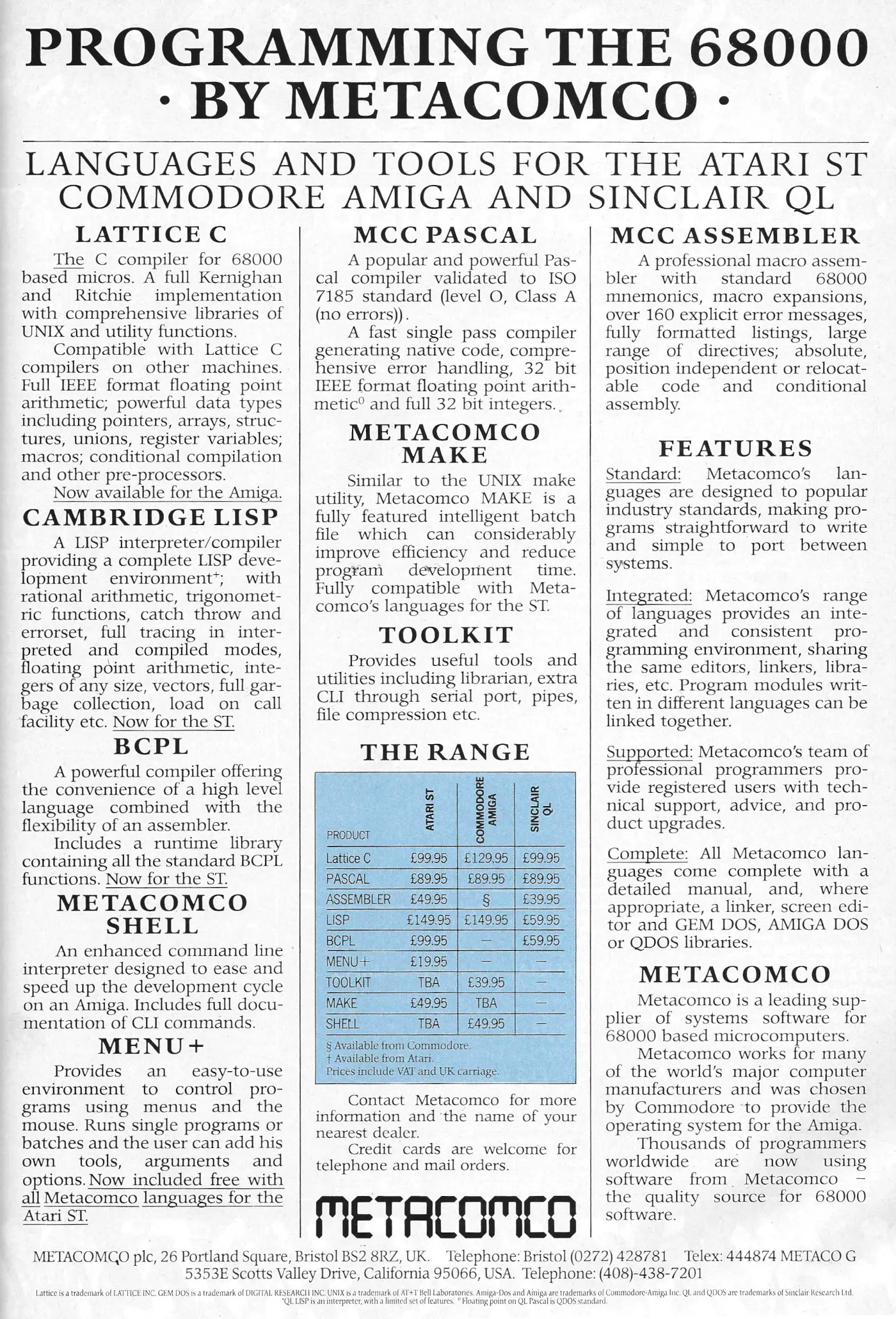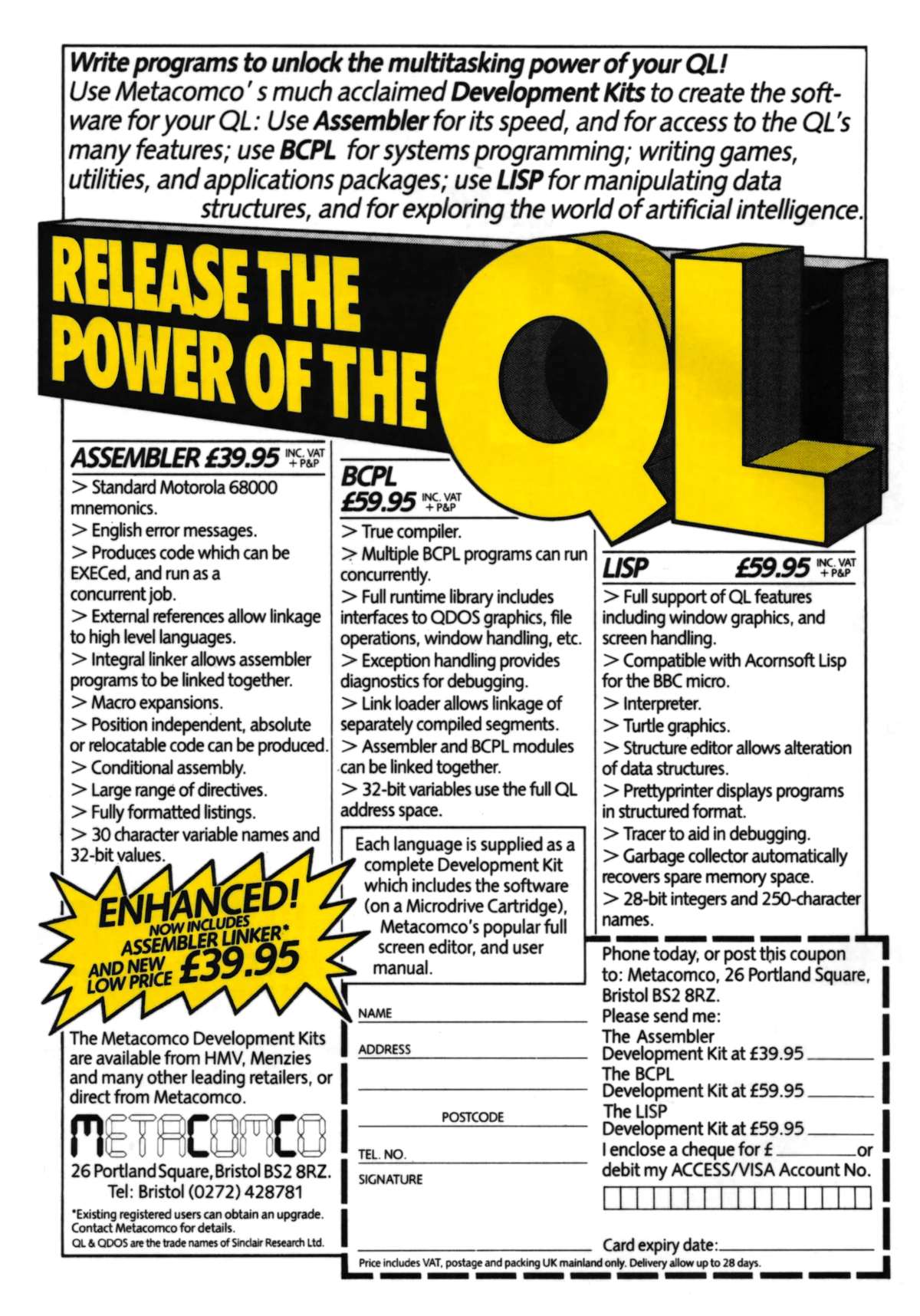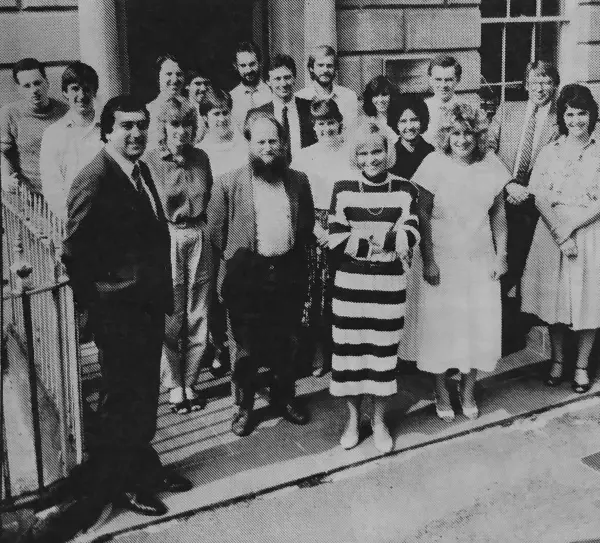Metacomco Advert - December 1986
From Personal Computer World

Programming the 68000 by Metacomco
St Pauls, Bristol-based Metacomco had been quietly writing system software and compilers for the Motorola 68000 processor, and had also previously licenced its own 8086 BASIC interpreter for $800,000 (about £2,413,900 in 2025) to Digital Research, but it wasn't otherwise well known.
Meanwhile, the development team working on Commodore's new Amiga had been writing its own message-passing and storage-allocation kernel, but when it became clear that they were running out of time to develop an actual operating system, the tiny Metacomco was contracted to provide one for the new machine. Metacomco's marketing manager Peter Mackeonis recounted:
"Some Amiga people came to our stand at Las Vegas CES in 1984 and asked if we did anything on operating systems. Four months later they rang up and asked for a list of our ideas for a new machine".
The company won the contract only six months before the Amiga's US launch, but had something of a headstart as it already had a suitable single-user multi-tasking operating system in the form of Tripos, which had been developed at Cambridge University's Computing Laboratory in the late 1960s as part of research into portable operating systems.
The name itself derived from the name of Cambridge's final-year exams, which in turn was apparently derived from the name of a three-legged stool. To its sometime-detractors, it was also referred to as the TRIvial Portable Operating System[1].
There was also another connection to Cambridge, as the development of Tripos was very much in parallel with that of the Cambridge Ring network - a slotted-ring, rather than token ring, network which ran with only three data packets circulating constantly on a 600 metre ring.
At the time, the network was running at an impressive-for-the-time 50mbps, and was thought to be the only network type that had low-enough latency to carry speech.
The Cambridge Ring was integrated with Tripos in such a way that computers could be attached to the network with no peripherals at all - no keyboard, screen or disks.
A simple terminal with a ring station could then use any other free computer as if it was sitting on the same desk, with every device on the network - plotters, printers, file servers an so on - running with a Tripos kernel and available as a network resource[2].

An advert for Metacomco's versions of Assembler, BCPL and Lisp running on Sinclair's QL. Both languages retailed for £59.95, or about £240 in 2025. From Personal Computer World, May 1985
Meanwhile, Metacomco had already ported two of its Tripos languages - an Assembler and BCPL, an ancestor of C - to the Sinclair QL, a 68008-based micro.
Nevertheless, producing an entire operating system for a new machine in only six months was certainly a tall order. Metacomco's Tim King, who had overseen the entire Operation Amiga from the beginning, said of the effort that:
"It was really hard work [and] I know at least three members of the Amiga team with camp-beds in their office. They even work weekends"[3].
King himself spent a lot of the time in a three-week rotation between Bristol, Monterey - where Metacomco had a small office - Commodore's HQ in Pennsylvania and Amiga on the West Coast of the US. Pam Clare, Metacomco's technical manager added:
"While our AmigaDOS is certainly adapted from Tripos, we have had to do a lot of modifications to make it acceptable for a modern system. We've had to customise it to make the best use of the Amiga's graphics and sound capabilities - getting it to address the Amiga's custom chips has been the major modification".

Metacomco staff outside their Bristol HQ. Tim King is front, left, whilst Derek Budge is second from right, © Personal Computer World December 1986Luckily for Metacomco, the Amiga's kernel - the Exec - "had been written by people who had clearly read a few books on operating system design", and thanks to Tripos's basis as an operating-system research project it turned out that Amiga's Exec and Tripos's usual kernel were not that dissimilar, so it was simple enough to switch over.
AmigaDOS became the new kernel, with Amiga device drivers being written in Assembler, whilst Tripos's task and file handlers were written in BCPL.
Elsewhere, Metacomco was not hanging around with other deals, as it was about to launch a version of C for the QL at the September Personal Computer World show, and as well as selling its existing versions of Assembler, BCPL, Lisp and Pascal for the QL, it was also on the cusp of launching software for the Atari ST - the main advert features software for all three machines.
However, it had ruled out the Apple Mac, launched the year before, as it considered its links with Digital Research to be more fruitful. Mackeonis said:
"I would like to see Metacomco become a major force in the market place - the new Digital Research if you like, but home grown".
Metacomco also saw its AmigaDOS as a "pre-Unix system" and intended to licence it to other micro manufacturers, with Mackeonis continuing:
"It's certainly a strong contender for the 'windows market'. As yet there is no standard operating system for the 68000 chip, so it would be good if we can get Tripos going now"[4].
Atari was one company that had already expressed an interest in getting AmigaDOS - or more specifically Tripos - for its ST range of machines, as Atari's Siggy Hartmann, formerly of Commodore, had approached Metacomco and started negotiations at the beginning of 1986.
Atari was not limiting itself though, as it had also approached GST with its 68000-based K-OS, as well as a couple of other potential sources, including one supplying the Unix-like OS9. As Rob Harding, head of Atari UK, said:
"We want to open up the ST to all the software that there is."
There were also rumours that another UK comany - U-Micro, headed up by Bill Unsworth - was also interested in AmigaDOS. The company, which had just released 2MB and 4MB memory expansion boards for its U-man micro, was seriously discussing Tripos, with Unsworth stating:
"We'd like to have a multi-tasking single-user system, and if Tripos does this, we'll go that way".
There were further more-radical rumours that Commodore was even considering porting Atari's TOS - originally Tramiel Operating System, but which by now was claimed to be simply The Operating System[5] - to the Amiga, although Commodore's head of software development, former Commodorian Gail Wellington, suggested "Why would we do that?" when asked.
It was thought that this particular rumour may have originated with Digital Research, as TOS was based upon its CP/M 68k and GEM desktop system, and it was no doubt keen on anything that promoted its software. Seeing a potential fight with DR, Metacomco's Derek Budge suggested:
"I think it'll be an interesting battle. We're aware that Digital Research is now taking our operating system very, very seriously, which is why I believe you're hearing rumours of TOS on the Amiga. And we're getting ready for the fight"[6].

Dr Tim King of Metacomco, © Personal Computer World September 1988The version of Tripos that Tim King of Metacomco had based AmigaDOS on had been licenced from the University of Bath, although the software itself was actually public domain, with many other versions available from both the University of Bath and Cambridge University.
This became relevant when King, plus two or three other members of staff, left Metacomco to join a new British company called Perihelion, founded by Jack Lang - a situation which no doubt gave Commodore some headaches and which led to a rift between King and the chairman of Metacomco, Derek Budge.
After leaving, King approached Commodore to offer to maintain the code that he had written - acknowledging that any royalties still belonged to his former company.
Meanwhile Budge, who had apparently acquired more Metacomco shares in order to "tighten up decision making" - a move that King was opposed to and which led to the split - reckoned that Tripos didn't belong to King and that any support work should be done under contract to Metacomco.
King however believed that the contract between Metacomco and Commodore ended as soon as he had left Metacomco, but either way, it seemed that no-one was quite sure exactly who had the rights to support and maintain AmigaDOS, and Commodore wanted the situation cleared up.
This was a view echoed by Guy Kewney in his December 1986 edition of Newsprint, when he wrote:
"those of us who feel that the Amiga is an important step forward in personal computing should feel the same way - Commodore has had enough bad luck with the machine already, and it will be a tragedy if this dispute causes it to fall further behind"[7].
Perihelion would later go on to develop Atari's ABAQ Transputer computer system.
Date created: 26 February 2019
Last updated: 28 November 2025
Hint: use left and right cursor keys to navigate between adverts.
Sources
Text and otherwise-uncredited photos © nosher.net 2025. Dollar/GBP conversions, where used, assume $1.50 to £1. "Now" prices are calculated dynamically using average RPI per year.